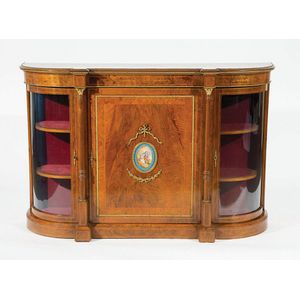Gilt Bronze Walnut Credenza with Sevres Porcelain Plaque
You must be a subscriber, and be logged in to view price and dealer details.
Subscribe Now to view actual auction price for this item
When you subscribe, you have the option of setting the currency in which to display prices to $Au, $US, $NZ or Stg.
- Victorian Period - The Victorian period of furniture and decorative arts design covers the reign of Queen Victoria from 1837 to 1901. There was not one dominant style of furniture in the Victorian period. Designers used and modified many historical styles such as Gothic, Tudor, Elizabethan, English Rococo, Neoclassical and others, although use of some styles, such as English Rococo and Gothic tended to dominate the furniture manufacture of the period.
The Victorian period was preceded by the Regency and William IV periods, and followed by the Edwardian period, named for Edward VII (1841 ? 1910) who was King of the United Kingdom and the British Dominions and Emperor of India for the brief period from 1901 until his death in 1910. - Bronze - An alloy of copper and tin, traditionally in the proportions of about 9 parts of copper to 1 part of tin.
The discovery of bronze in Western Asia in the 4th century enabled people to create metal objects which were superior to those previoulsy possible because of its strength and hardness, and it has been used throughout the world for weapons, coins, tools, statuary and other decorative items.
It is very fluid in a molten state, and its hardness, strength when set, and non-corrosive properties makes it most suitable for casting sculpture. - Marquetry - In marquetry inlay, contrasting woods, and other materials such as ivory, shell and metal are inlaid either as panels or in a single continuous sheet over the surface of the piece. The design may be straightforward, such as a shell pattern or a basket of flowers, or it may be infinitely complex, with swirling tendrils of leaves, flowers and foliage, such as one finds, for example, in the "seaweed" patterns on longcase clocks of the William and Mary and Queen Anne periods.
- Pilasters - In furniture a pilaster is a flattened column-like detail
applied to furniture. It is similar to a pilaster in architecture, but it is
typically smaller and less ornate. Pilasters are often used to decorate the
fronts of bookcases, cabinets, and other pieces of furniture. Pilasters can be
made of wood, metal, or other materials. They can be fluted, carved, or plain.
Pilasters are often used to add a touch of elegance and sophistication to
furniture. - Column - An architectural feature sometimes used for decorative effect and sometimes as part of the supporting construction. Columns should generally taper slightly towards the top. They may be plain or decorated with carving, fluting or reeding. Columns may be fully rounded or, more commonly, half-rounded and attached with glue, screws or pins to the outer stiles of doors, or the facing uprights on cabinets and bureaux.
This item has been included into following indexes:
-
cabinets, material
- ormolu and bronze mounted 232
- painted 158
- walnut 675
- credenza - without mirror back 123
Visually similar items

A fine 19th century burr walnut credenza, the shaped rectangular top above two bowed glazed doors and a porcelain plaque inset central panelled door, the whole with marquetry inlay and gilt metal mounts, raised on a plinth base, 104 x 158.5 x 46 cm

Late Victorian credenza, ebonised walnut with ormolu mounts, fluted gilded columns two glazed convex side doors and central painted porcelain plaque depicting young lovers length 150 cm

Victorian walnut inverted breakfront credenza central panel door with painted Sevres style oval plaque, flanked by shelving enclosed by bowed glass doors, fluted tapering column supports on box base, the whole with gilt metal mounts

A Louis XV style marble topped Tulipwood pier cabinet, having an exaggerated serpentine profile with ear form three quarter pillars, a mottled beige marble top above a frieze drawer and a single cupboard richly adorned with trompe l'oeil inlay style decora
